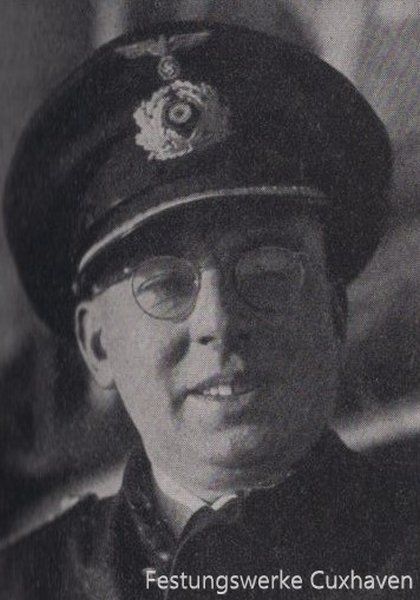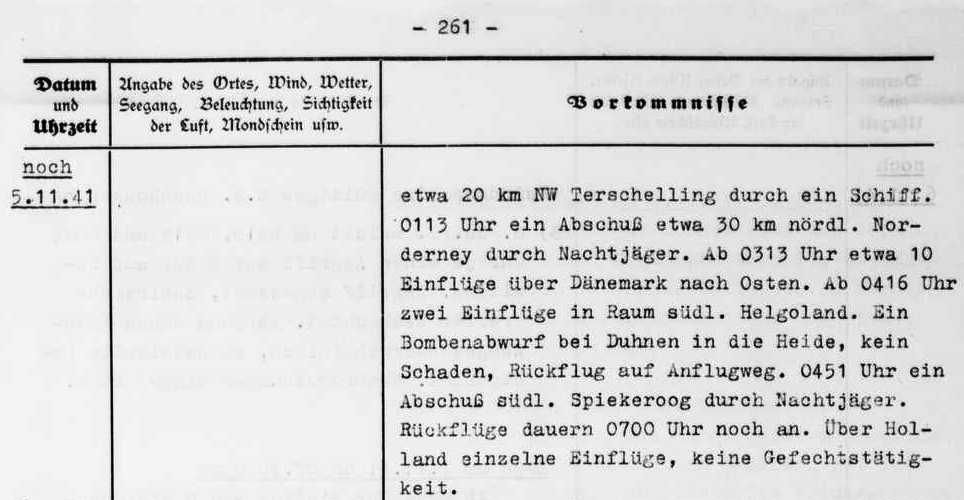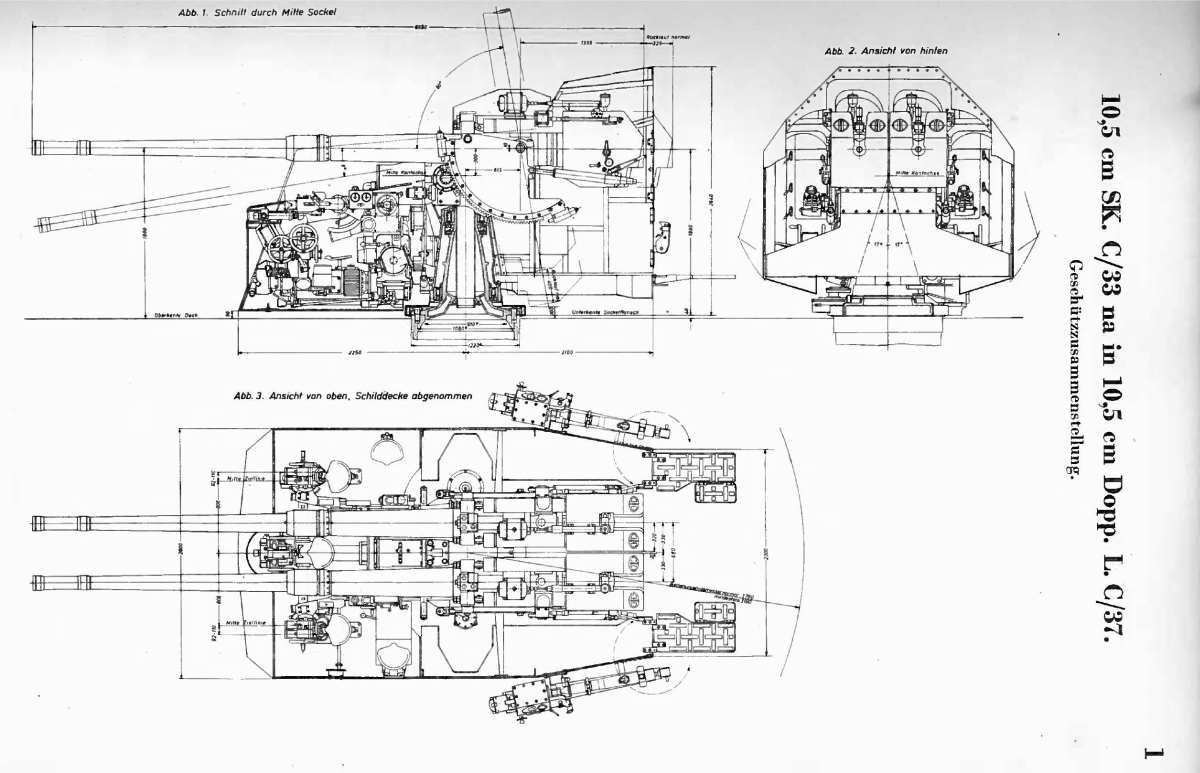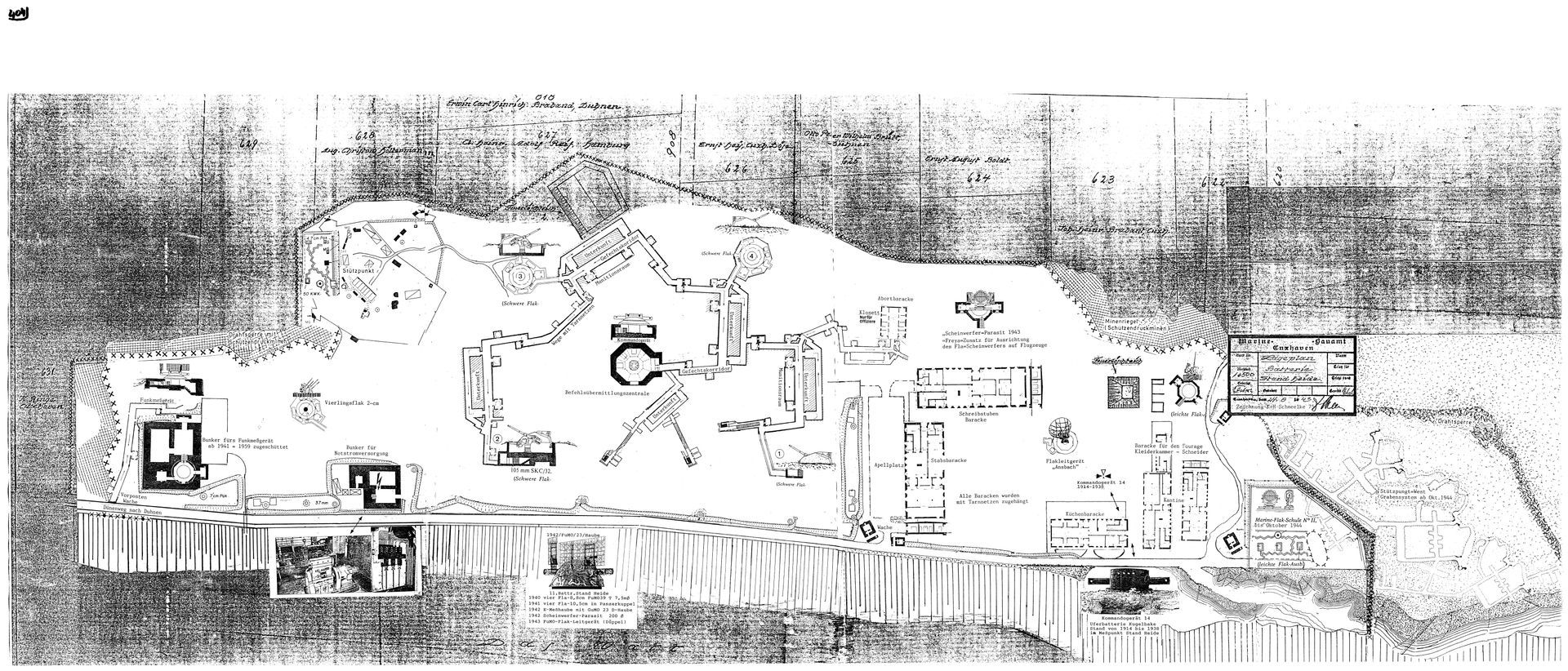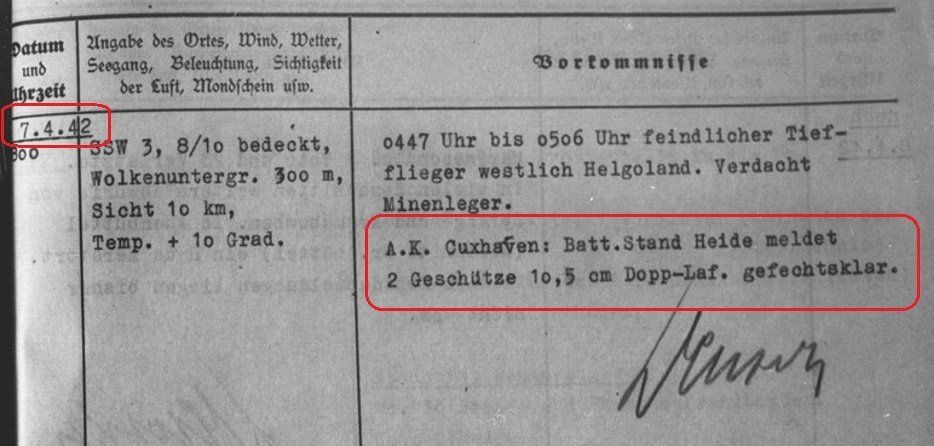Zum erster Batteriechef von Stand Heide wurde Leutnant Decker ernannt. Über seinen militärischen Werdegang selbst ist nicht viel bekannt. Er wechselte bereits am 14.03.41 auf den Flakkreuzer Nymphe.
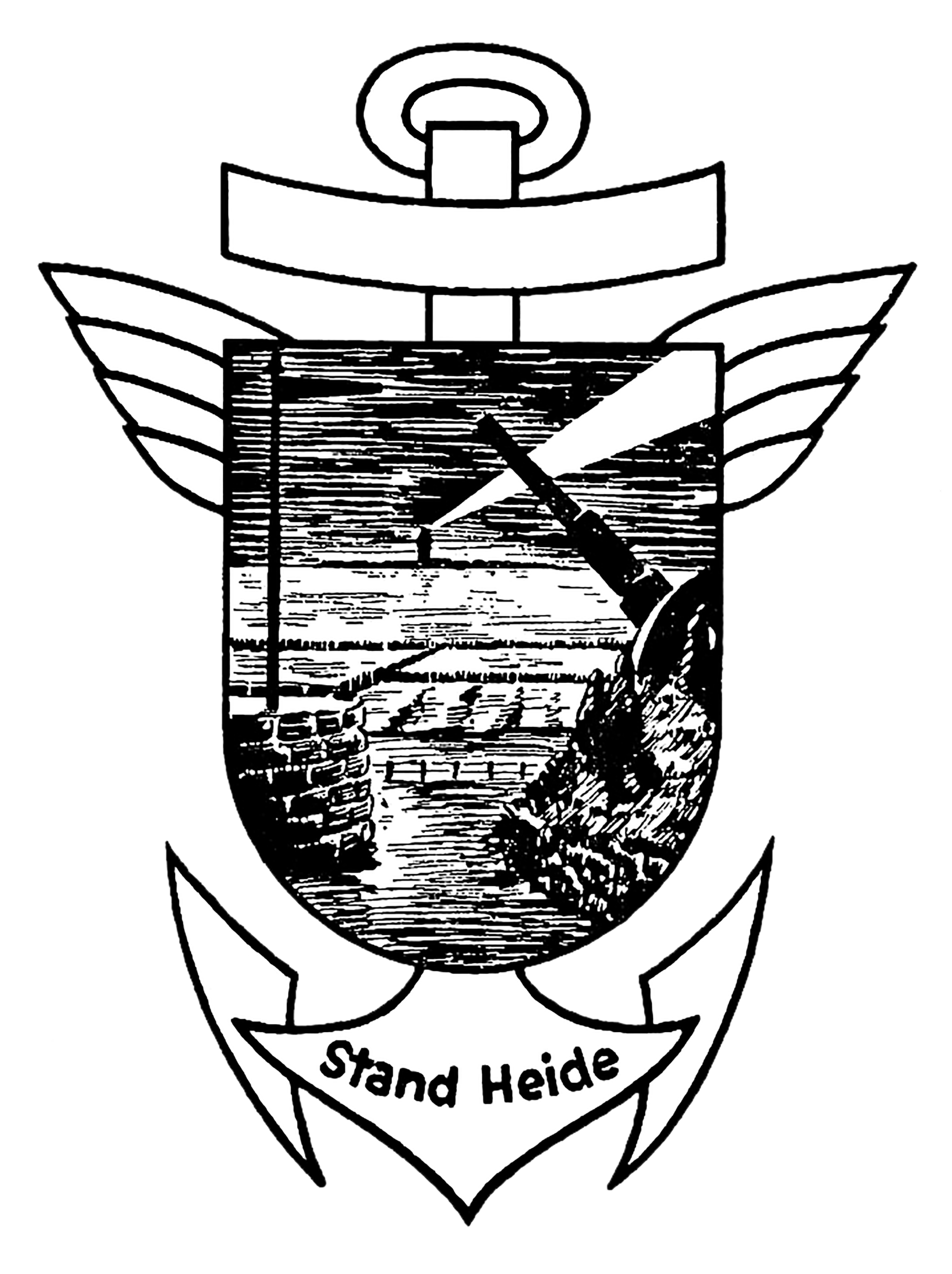

The construction in 1940
1940 wurde damit begonnen, an der nordwestlichen Seite Duhnens in Höhe des heutigen Aussichtsturms am Dünenweg zur Abwehr englischer Flugzeugangriffe eine Luftabwehrstellung zu errichtet. Unmittelbar an der Deichlinie wurden durch die Baukompanie des RAD Sahlenburg, südlich in der Dünenlandschaft die grau gestrichenen Holzbaracken und Bettungen der Batterie verwirklicht. Offensichtlich kamen die Arbeiten nach Berichten allerdings anfänglich schleppend voran. Vermutlich nahmen die Baumaßnahmen auf Grund der Objektage doch längere Zeit in Anspruch.
Statement: - the beginning cannot be determined and the end cannot be foreseen - On the highest of the small hills on this heath, a command device 40 (simple targeting computer) and a fire control radar FuMO 22 were set up in the western part. A guard command was soon assigned and in October 1940 the foundations were given guns. Lieutenant Decker was appointed the first battery commander of the as yet unnamed position. Source: War Chronicle Battery Stand Heide 1941/42
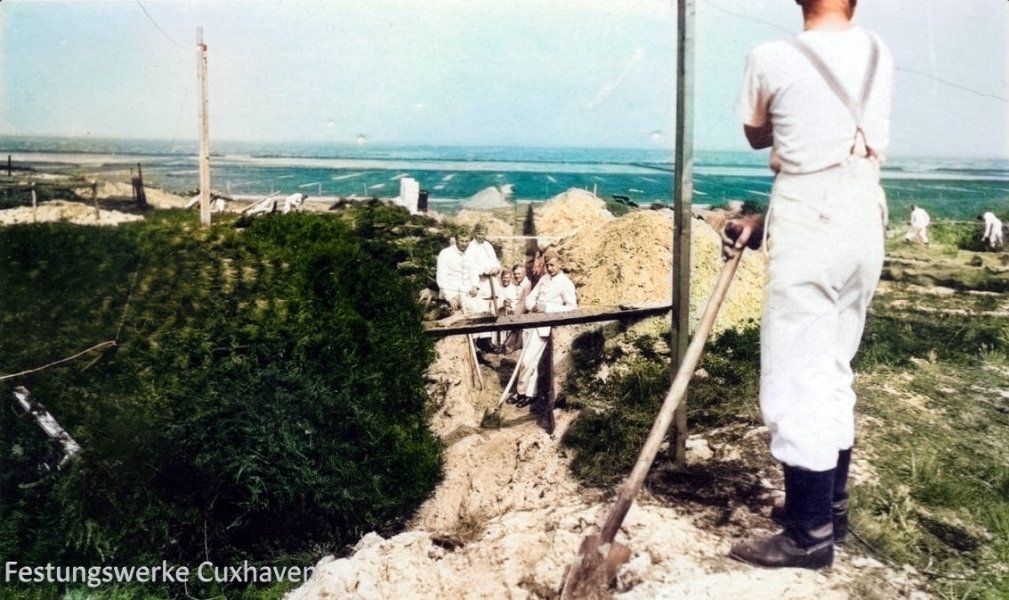
Start of the trench work by soldiers of the Reich Labor Service. In the background the Duhner new land reclamationSource Cuxhaven City Archives
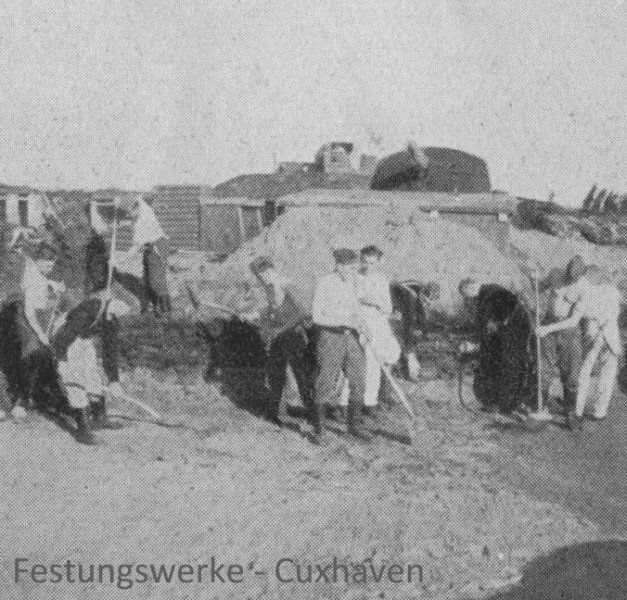
In front of one of the four 8.8 cm guns, in the background the anti-aircraft control station with the command device.Source: War Chronicle of the Battery Stand Heide 1941/42
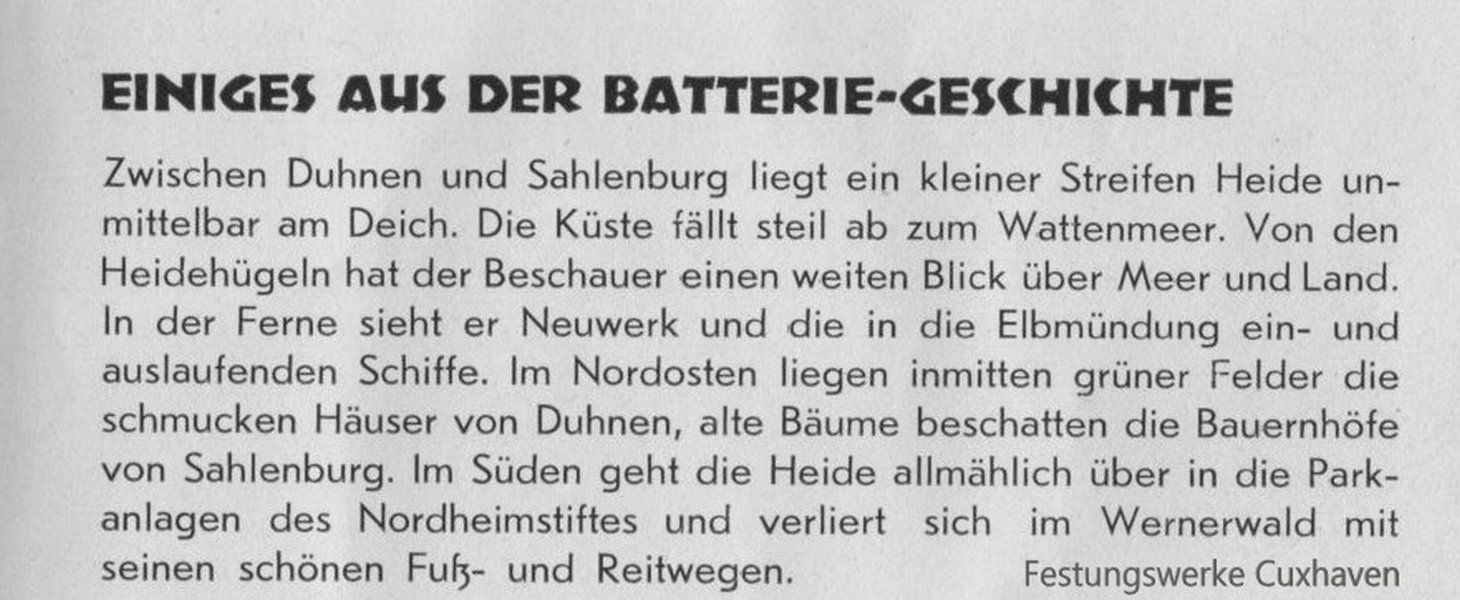
Quelle: Kriegskronik der Batterie Stand Heide 1940/41

Source: War Chronicle of the Battery Stand Heide 1941/42
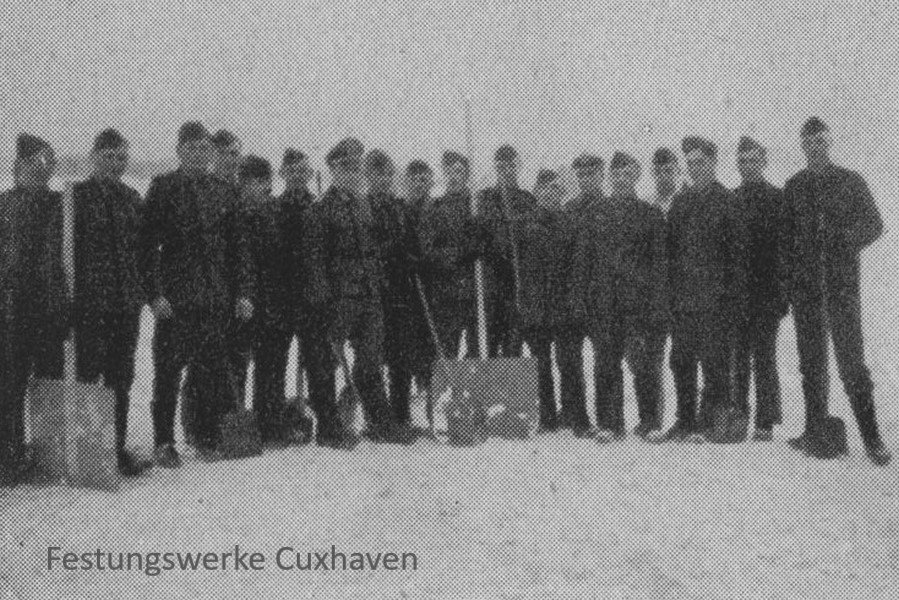
The winter of 1940/41 was cold and hard. Severe frost and lots of snow for several weeks. Mighty ice barriers formed on the mudflats and prevented supplies from reaching the island of Neuwerk. The battery's main task at the time was shoveling snow.
Source: War Chronicle of the Battery Stand Heide 1941/42
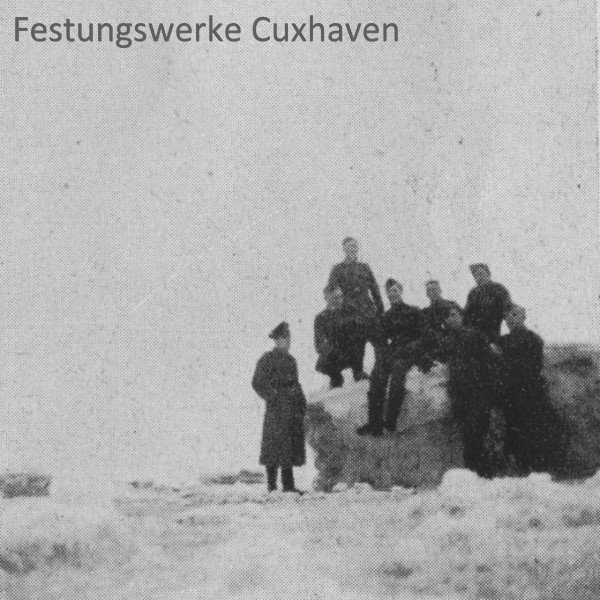
Source: War Chronicle of the Battery Stand Heide 1941/42
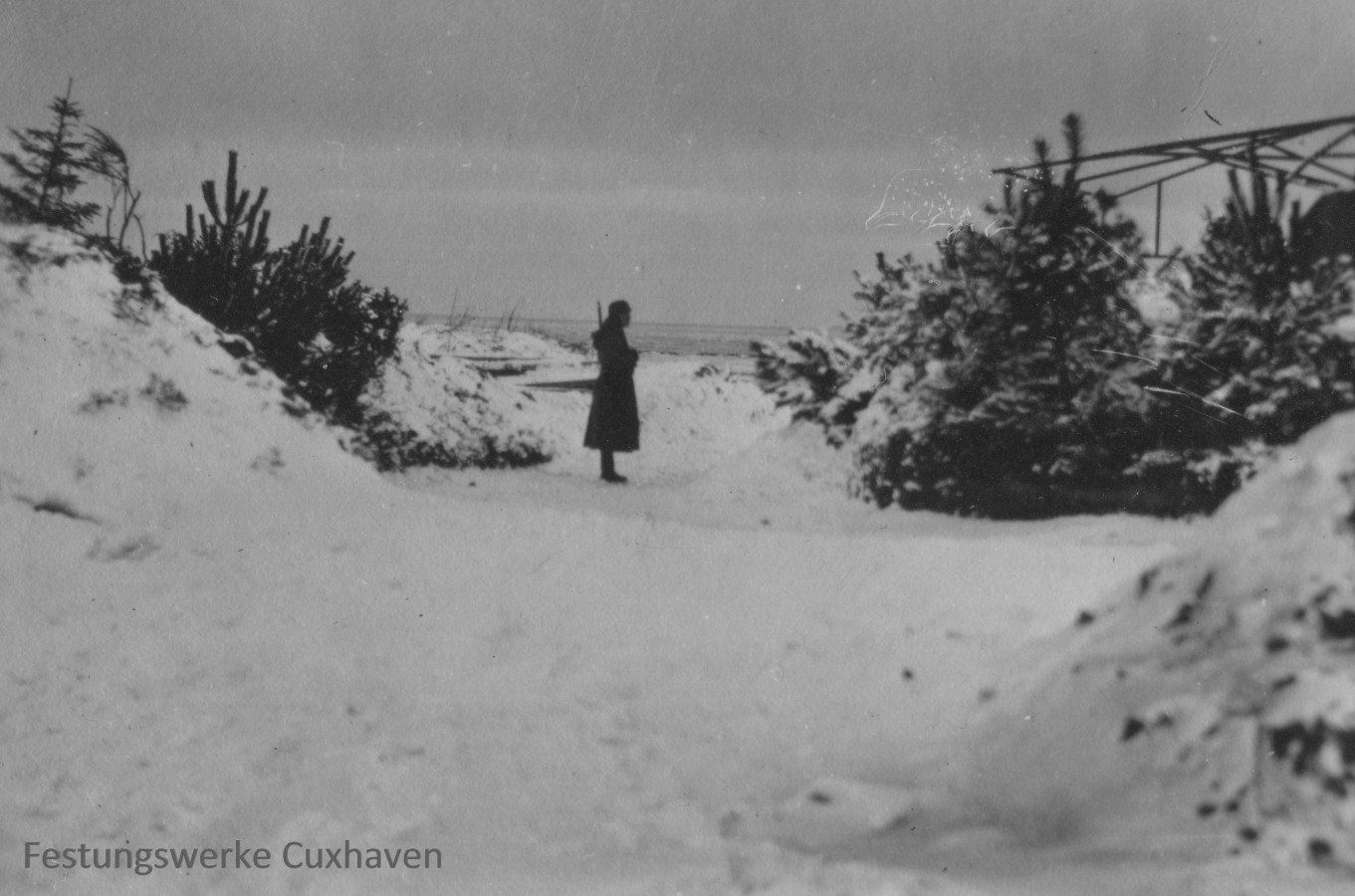
The battery entrance still unpaved in the winter of 1940/41
Source: War Chronicle of the Battery Stand Heide 1941/42
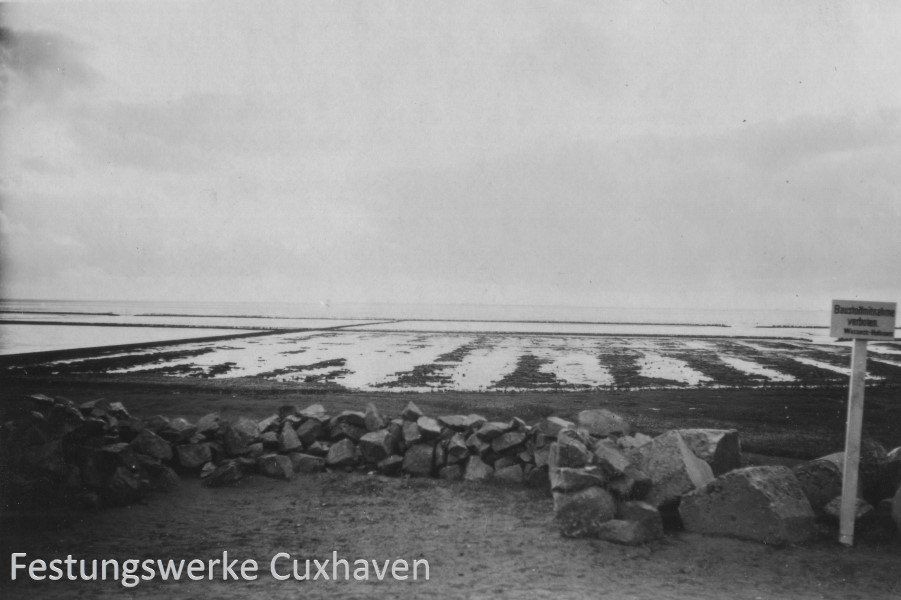
Spring 1941, the expansion continues
Source: Cuxhaven Fortifications/MB
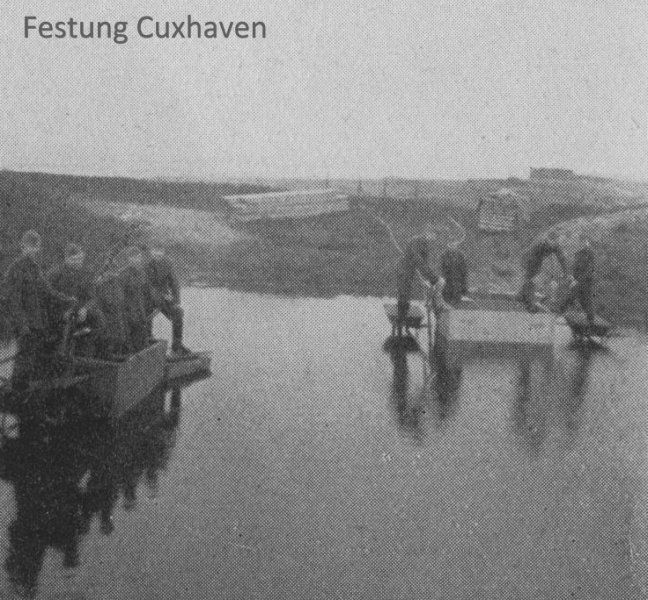
Initially, the battery was under water in many places, especially during long periods of rain. This constant dampness and cold was depressing for many soldiers.Source: War chronicle of the battery at Heide 1941/42
When the first marines from the other batteries in the Cuxhaven sector had to move to the construction site of the new anti-aircraft position at the end of 1940, they were obviously "not delighted" with their future area of activity: - As grey as the rainy autumn days were, the new battery initially looked just as grey and desolate. Everything was missing, so to speak. The soldiers complained about damp, cold living quarters, inadequate shower and toilet facilities and poor canteen food. Thanks to the manual skills of the individual comrades and the motivation of the first battery commander, the facility was made relatively livable within four weeks. But drill service and artillery training were not neglected during the ongoing repair work. The winter of 1940/41 also turned out to be a tough nut to crack for the "Stand Heider". Weeks of bitter cold, snowstorms and shoveling snow did not exactly create a good mood. Chief Decker was apparently very keen to keep his soldiers happy by offering variety and spending evenings together, which he obviously managed well. But it became even more difficult when the thaw set in and the southwest storm brought warmth and rain overnight, alternating with black ice and snow. The unchannelled frozen ground prevented the water from getting through, and it entered the bunkers through doors and cracks in the floor, so that endless pumping and scooping were necessary. In the lowest bunker, "Heideröschen", the water was 20 cm deep, so that a small "race" had to be held before getting into the bunks.
Source: War Chronicle of the Battery Stand Heide 1941/42

Canalization of the facilitySource: War Chronicle of the Battery Stand Heide 1941/42
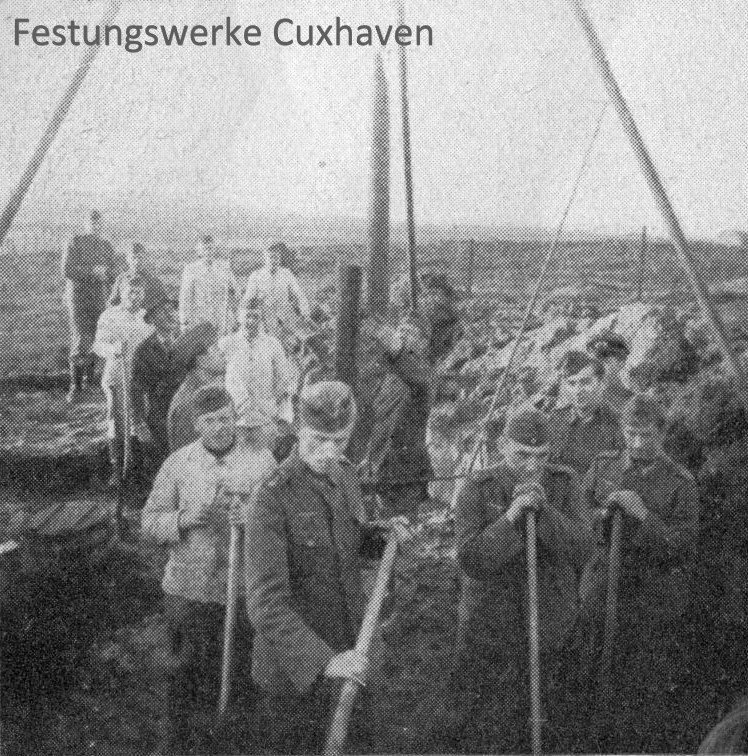
Hard work in position constructionSource: War chronicle of the Battery Stand Heide 1941/42
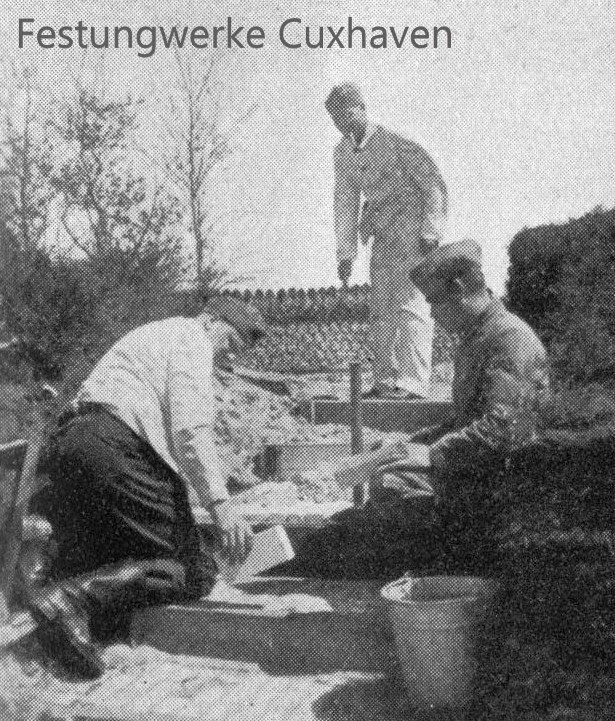
Pflasterarbeiten in der Stellung
Quelle: Kriegschronik der Batterie Stand Heide 1941/42
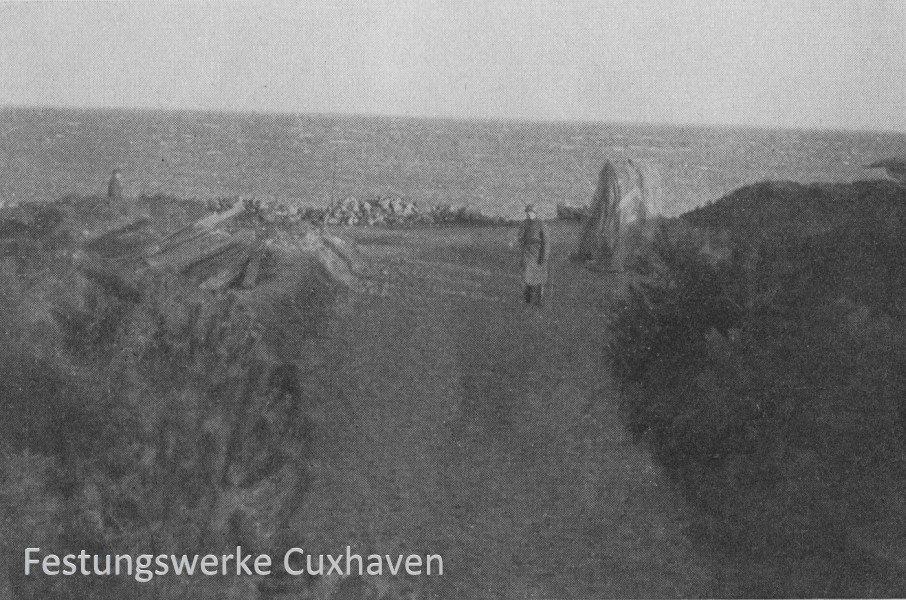
View over the entrance to the sea, before.
Source: War Chronicle of the Battery Stand Heide 1941/42
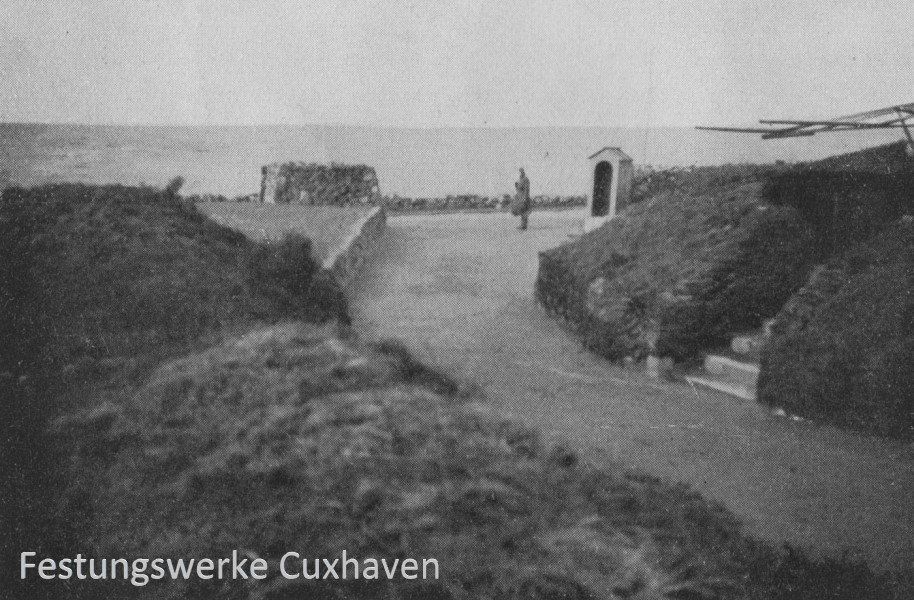
View over the entrance to the lake after completion
Source: War Chronicle of the Battery Stand Heide 1941/42
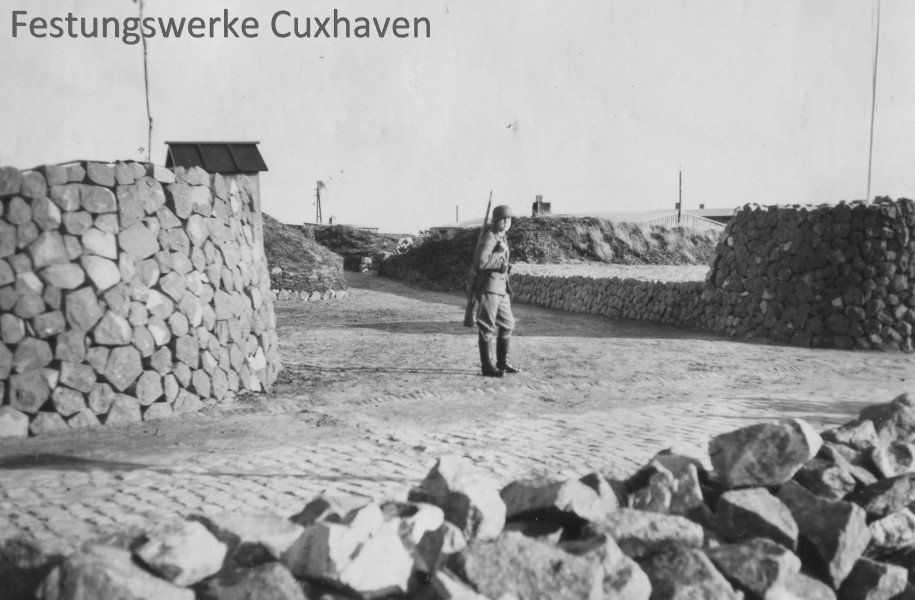
The entrance seen from the sea side, on today's Dünenweg.
Source: Cuxhaven Fortifications/MB

Source: War Chronicle of the Battery Stand Heide 1941/42

Source: Cuxhaven Fortifications/MB
The heavy anti-aircraft position "Stand Heide" in spring 1941 from the west. It was officially put into operation on November 2nd 1940. Its main armament for combating high-flying aircraft consisted of three 88 mm SKC 30s in 1940 and then finally four 88 mm SKL 45 quick-loading cannons with frontal protective shields in early 1941. These were former naval guns that had already been used in WW1. According to the battery chronicle, the crew was very surprised by the age of the cannons, which were a good 30 years old. Quote: - There was a whisper that they were not the very best; but later it quickly became clear that the opposite was the case. The hill in the middle was the command post with the command device. On the left is a crew barracks at the entrance to the position. In the background you can see Duhnen with the Wehrberg. The area of the Duhner Feldmark, in contrast to today, was completely devoid of any vegetation at that time.
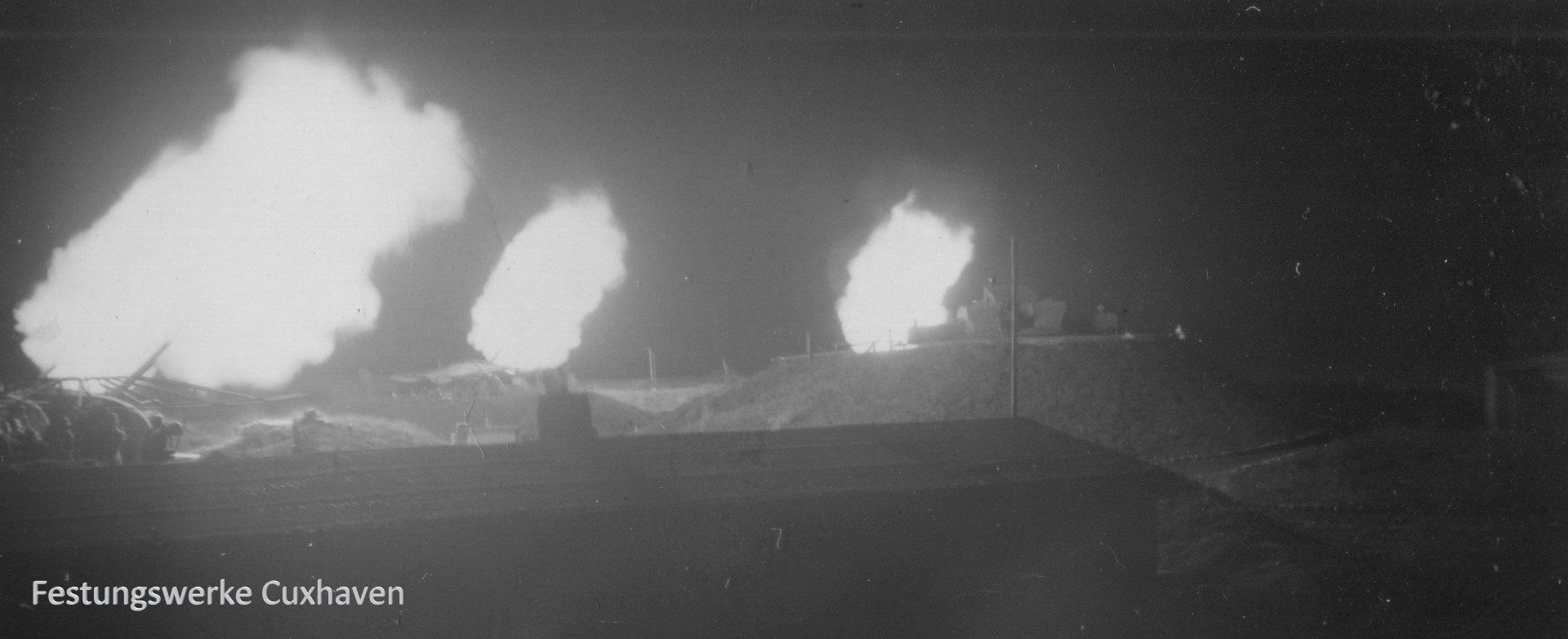
Source: Cuxhaven Fortifications/MB

Source: Cuxhaven Fortifications/MB
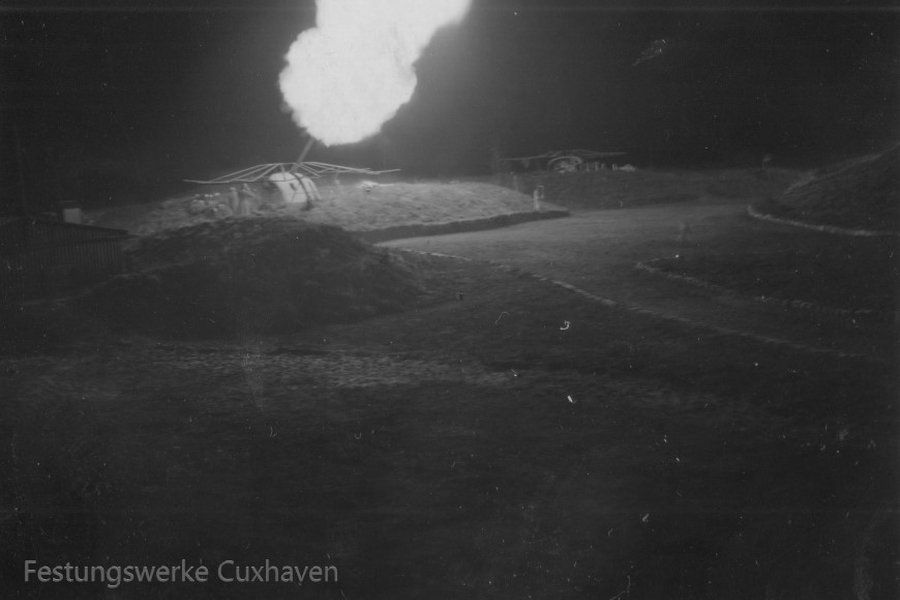
Source: Cuxhaven Fortifications/MB
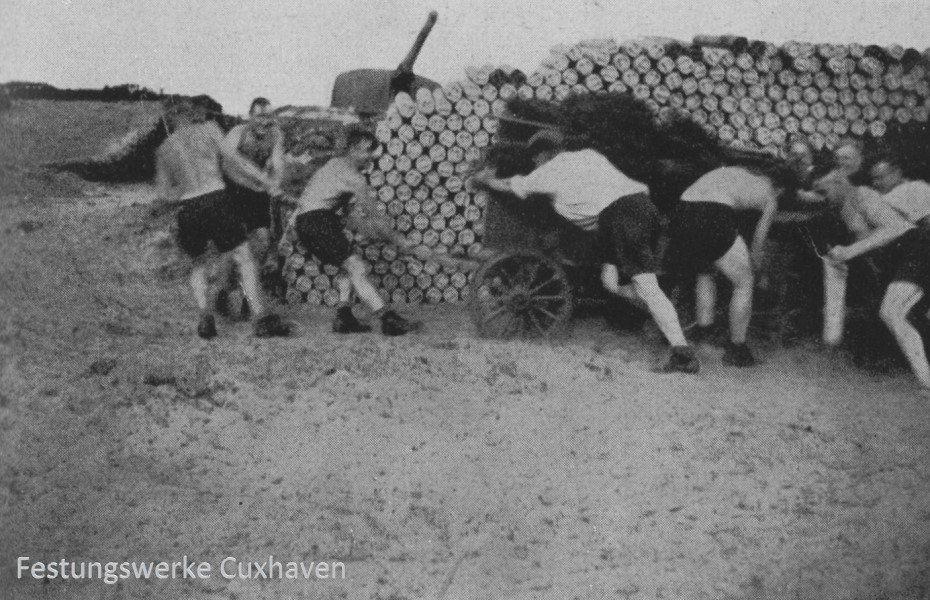
The position was strengthened at the time, often with great physical effort and sometimes with the simplest of tools. Here, for example, the transport of turf in front of a pile of empty shell casings. Behind it is an 8.8 cm anti-aircraft gun. Source: War Chronicle of the Stand Heide Battery 1941/42
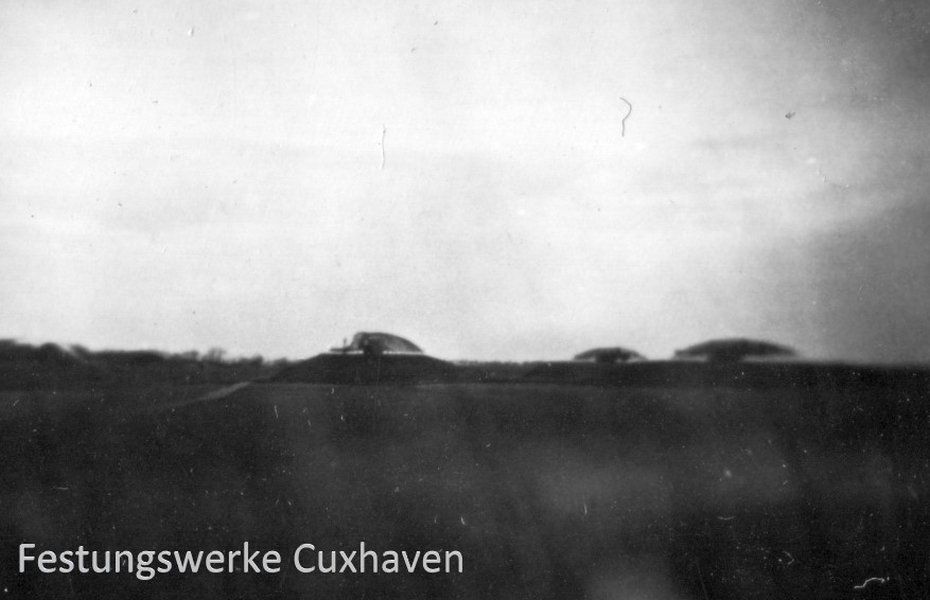
The heavy 8.8 cm guns under camouflage nets in their beds between the dunes of the Duhner Heide.Source: Festungswerke Cuxhaven/MB

Source: War Chronicle of the Battery Stand Heide 1941/42
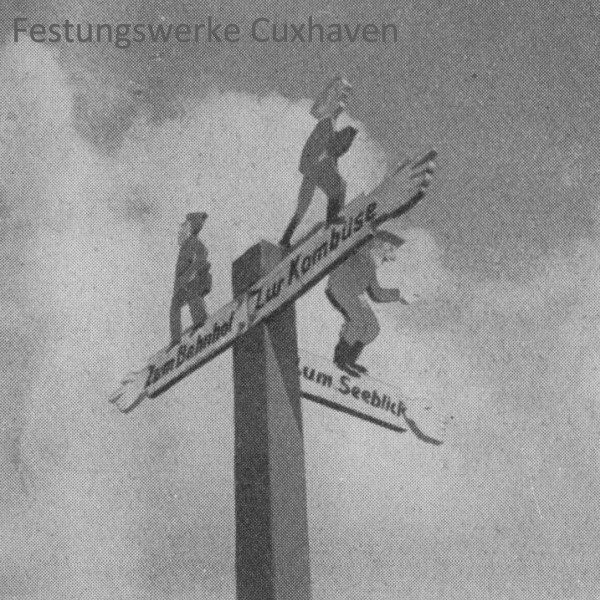
Source: War Chronicle of the Battery Stand Heide 1941/42
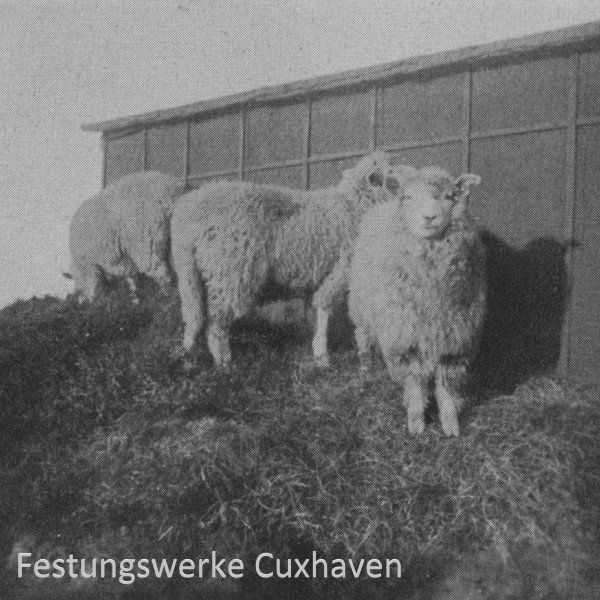
Source: War Chronicle of the Battery Stand Heide 1941/42
In addition to the war guards, training and all kinds of additional work, battery life was also very busy. In their free time, many members of the staff pursued their hobbies. Handicrafts, painting, poetry, music, gardening and much more helped to bridge the many monotonous hours. Animals such as sheep, chickens, rabbits, ducks and turkeys were also kept on the premises, mainly for their own needs. As can be read in the reports in the war chronicle, most of the staff obviously placed great value on togetherness and camaraderie. Apart from a few minor arguments, nothing else is known here. But these could not be allowed, as they usually ended with a report to the battery commander. Although being assigned to an anti-aircraft position in our coastal section was cold and uncomfortable, especially in the winter months, it was relatively safe in contrast to the soldiers directly at the front. Apart from a few bombings in the immediate vicinity of Stand Heide, there was only defensive fire against flying bomber formations and individual enemy aircraft, but no significant ground battles.Source: War Chronicle of the Stand Heide Battery 1941/42
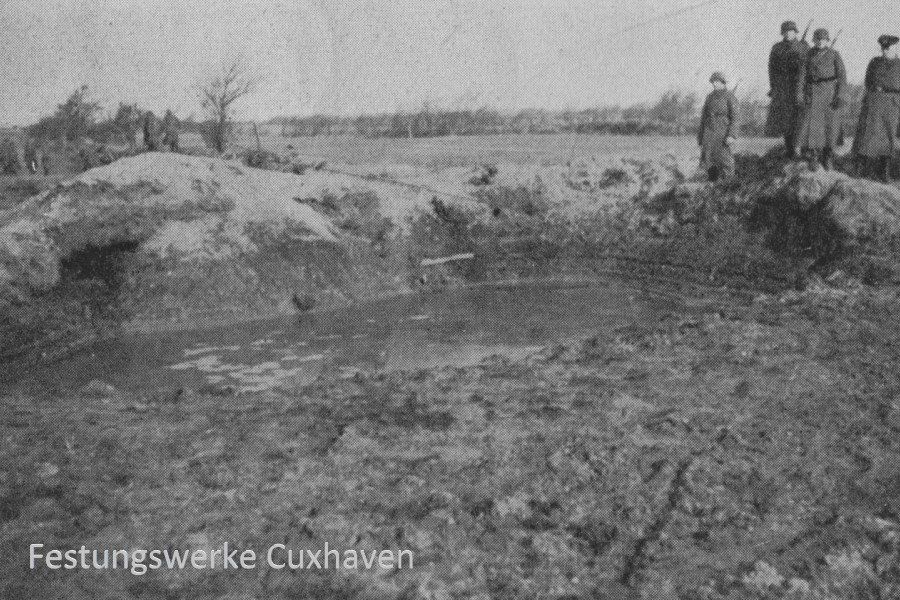
05.11.1941, bomb crater near the Stand Heide position. The exact point has not yet been identified. Source: War Chronicle of the Stand Heide Battery 1941/42

Standing from left: Battery Commander Lieutenant Decker, Sergeant Schönfeldt, Sergeant Wietling.Source: War Chronicle of the Battery Stand Heide 1941/42
Expansion of the battery / The following texts are from the battery chronicle 1941/42 and are partly shortened
On March 14, 1941, Lieutenant Decker left the Heide position to begin his service on the anti-aircraft cruiser Nymphe. On that day, Lieutenant Hansen took over command of the battery until the new commander arrived.
There followed a period without cannons, which was used to overhaul and perfect the theoretical and practical training of infantry and artillery. The position here obviously received similarly constructed 88 mm replacement guns SKL 45. On April 19, 1941, Lieutenant Commander Brune took over the battery. In the meantime, the new cannons had also arrived.
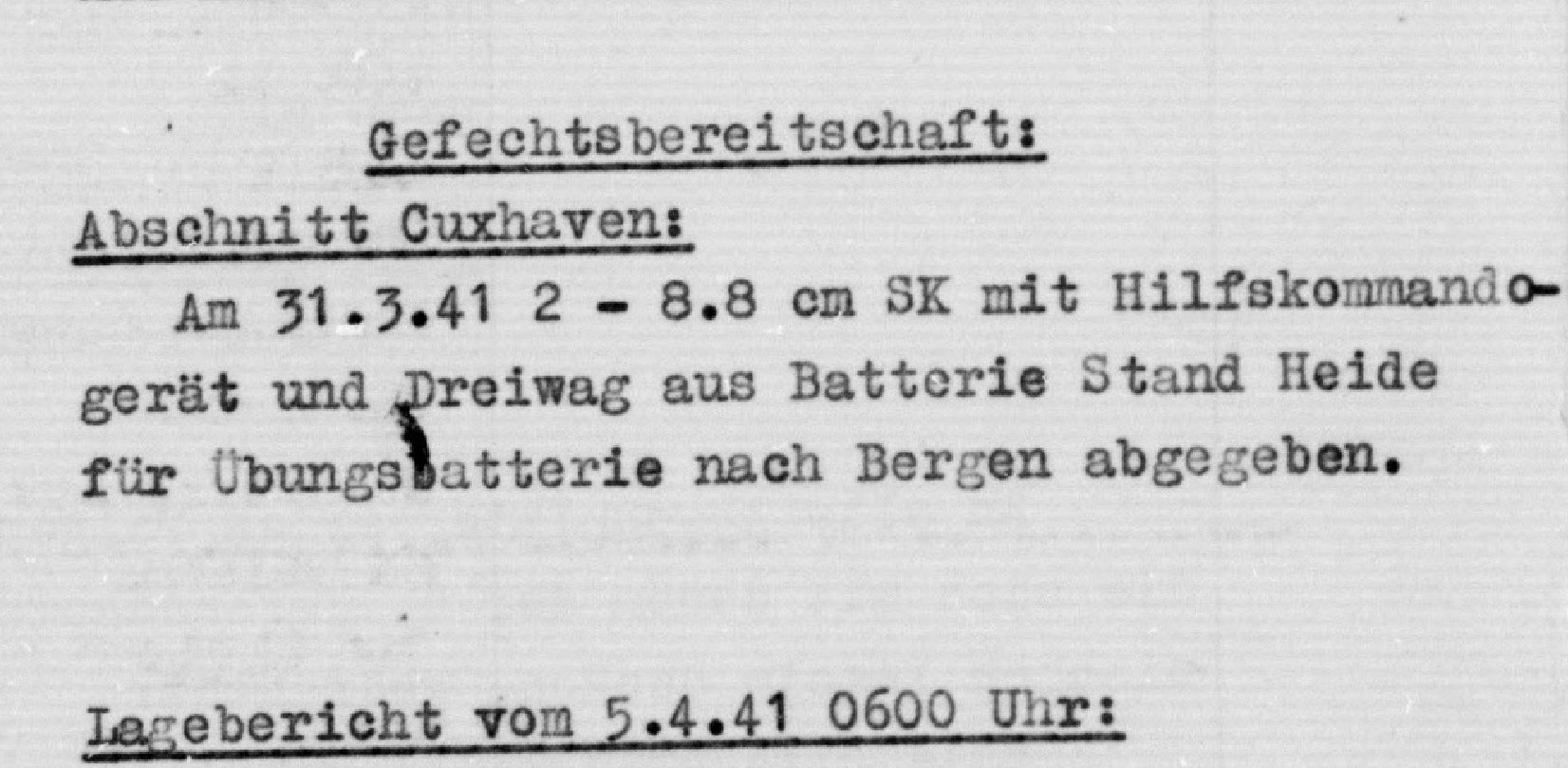
Source: War Chronicle of the Battery Stand Heide 1941/42
The deficiencies revealed in the winter were tackled decisively and generously. The battery was soon unrecognizable. Digging, pitting, carpentry were carried out in every corner, water pipes were laid, canals - 5 m and deeper - and drainage was carried out. The bunkers were given washrooms and urinals, the walls were lined with strips on the outside and lightweight panels on the inside, built-in closets held coats, and gazebos and attractive seating areas were created.
Through skillful negotiation and a tough fight, Captain Brune managed to build a new barracks that was 50 m long and 12 m wide. Not only did battery officers, an office, recruits and others find space here, but toilets, shower rooms and a beautiful library were also built.
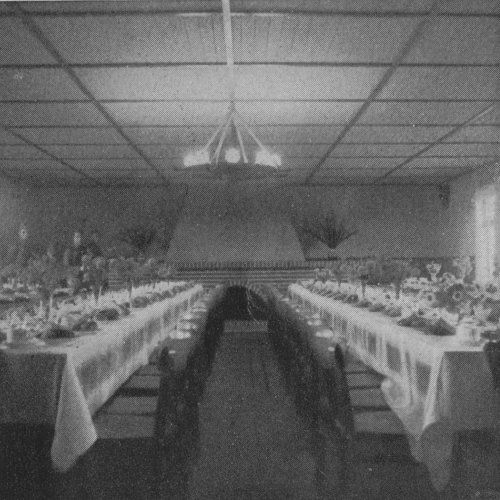
Source: War Chronicle of the Battery Stand Heide 1941/42

Source: War Chronicle of the Battery Stand Heide 1941/42
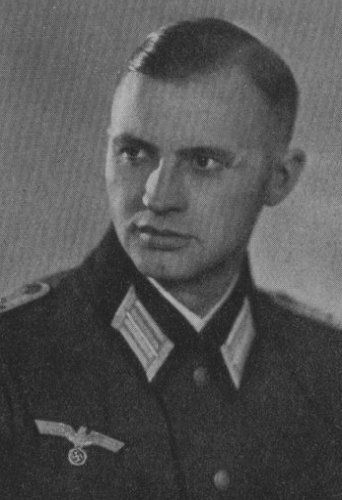
Lieutenant HansenSource: War Chronicle of the Battery Stand Heide 1941/42
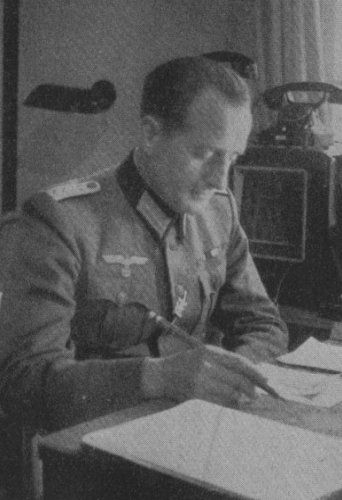
Lieutenant Commander BruneBattery Commander 17.04.41 - 11.05.42Source: War Chronicle of the Battery Stand Heide 1941/42
Die auszuführenden Arbeiten waren sehr umfangreich und teilweise äußerst schwierig. Batteriefremde Arbeitskräfte standen nicht zur Verfügung, so daß alles mit eigenen Kräften gemacht werden musste. Die Arbeiten konnten daher nur bewältigt werden, wenn jeder mitarbeitete. Der Batteriechef verstand es, nicht nur während der Dienststunden jeden voll einzusetzen, sondern darüber hinaus während der Freizeit die Kameraden zur freiwilligen und freudigen Mitarbeit heranzuziehen.
Each comrade was given the personal task of improving his living quarters and the battery. A bunker competition with various crates of beer and other prizes increased the enthusiasm for the work.
Weiterhin wurde ein fünf Meter tiefer Pumpenbrunnen gebaut, um eine der Zeit mustergültige große Kläranlage zu bauen.
Two mighty stone gate pillars made of stone blocks were built at the battery entrance after a first modest attempt failed due to rain and storms. The various rooms were given exemplary interior design and, as the crowning glory of the work, the new common room was created with a four-meter-wide brick fireplace and a cool cellar room.
On September 17th, the new common room was officially inaugurated with pride in the work that had been done.Source: War Chronicle of the Battery Stand Heide 1941/42
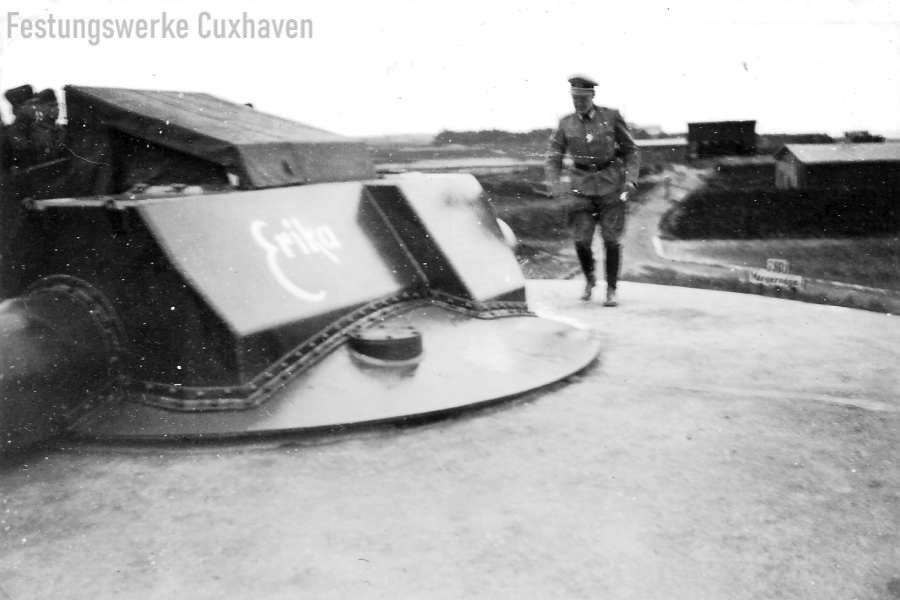
The Dreiwag measuring device "Erika" was located in the center of the four anti-aircraft guns. The view is to the west towards the Duhner Heide.Source: Oliver Weklinski Collection
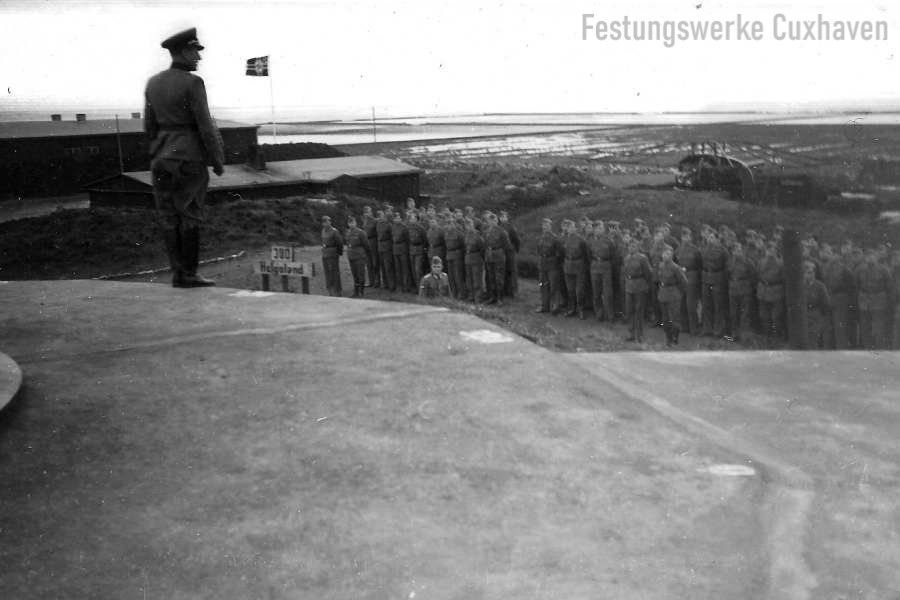
Lieutenant Brune speaking to his soldiers. In the background the Duhner land reclamation and the Wadden Sea.Source: Oliver Weklinski Collection
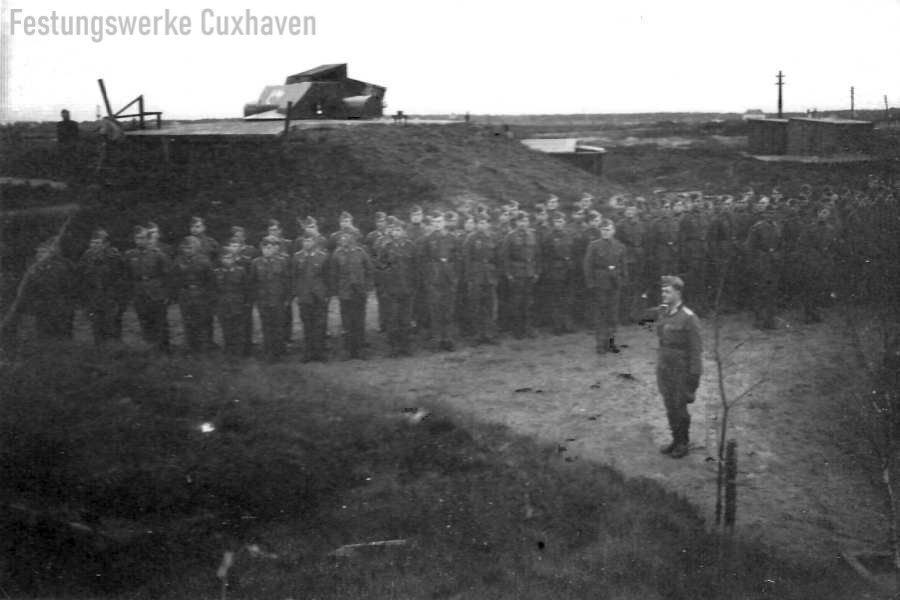
Line up on the roll call area in the courtyard of the position. The three-car could be rotated 360 degrees. In the background to the left of the electricity pylon you can see the customs house on Nordheimstrasse in Sahlenburg. Source: Oliver Weklinski Collection
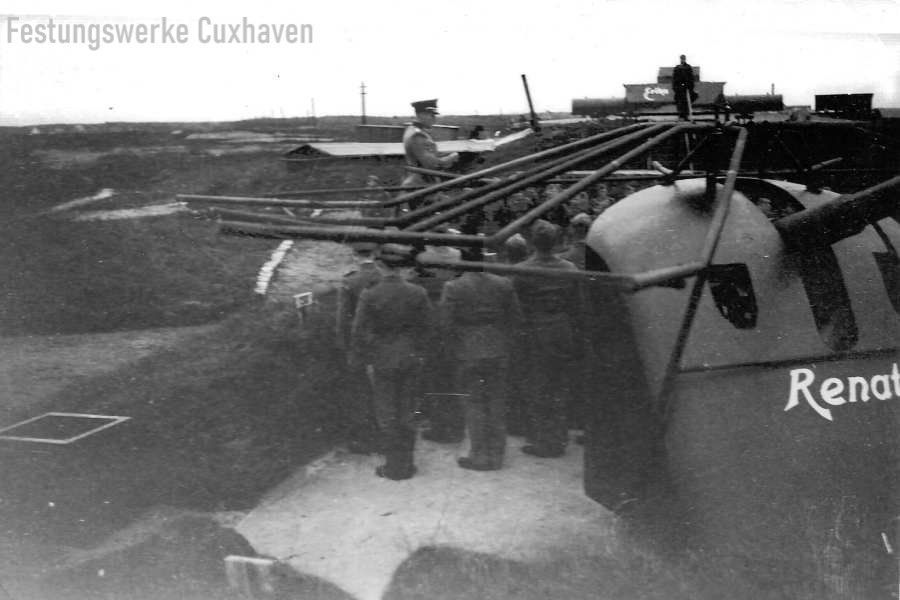
The 8.8 cm gun "Renate" on the east side of the position. The frame was used to attach the camouflage net. View to the west towards the Duhner Heide. Source: Oliver Weklinski Collection
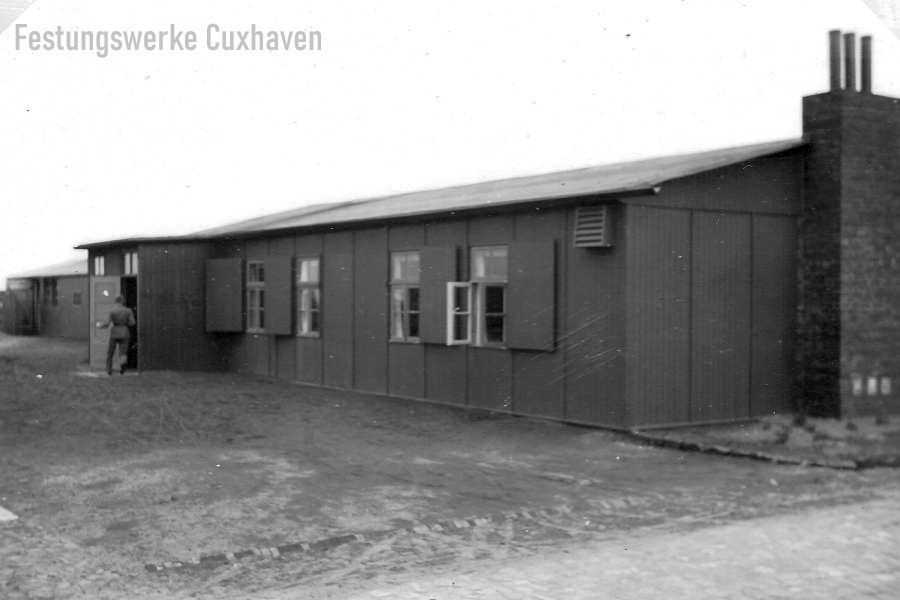
The former canteen with the common room, behind it the barracks of the supply depot. Today the "Duhner Heide" observation tower stands on this site. In the foreground the Dune Path. Source: Oliver Weklinski Collection

The officers at a battery party in gala uniform, in the middle Fritz Brune. The original cobblestones of the Dünenweg are still under the tarmac of the road. Source: Oliver Weklinski Collection
As the expansion work continued, the entire anti-aircraft battery was secured against attacks from outside with a barbed wire fence. In addition, communication trenches were built in various areas of the facility to protect the security soldiers, some of which can still be seen today. On the seaward side, the entire area of the front dike line in front of the position was made impassable with mines. Presumably, in the event of an invasion or sabotage, the danger of an attack on the battery from the sea was seen here. After the war, the area of the security belt was largely cleared and freed of the mines, although it appears that not all of them could be found. In the early 1950s, the farmer Ewald Braband from Duhnen drove a horse-drawn farm wagon through the area of the new land reclamation to collect driftwood to cover potatoes. In doing so, he drove over a remaining mine with one of his rear wheels. The explosion destroyed the farm wagon, but the load prevented the worst from happening; fortunately, the farmer was unharmed. The horses ran away and stormed over the dyke into the Duhner field. They were recaptured after a while and were also unharmed in this accident.
Sommer 1941 in Stand Heide.
Trotz des vielen Arbeitsdienstes wurde die artilleristische Ausbildung nicht vergessen und die vielen gutsitzenden Grüße, die wir in zahlreichen sternen- und mondschönen Sommernächten - vor allen Dingen in den Monaten Mai bis September - dem einfliegenden Tommy entgegenschickten, bewiesen, daß Stand Heide „auf Draht" war. Überraschend und bezeichnend für den frischen Geist der „Stand-Heider" war, daß sie trotz der arbeitsreichen Tages- und durchwachten Nachtstunden, trotz Sodenfahren und Schlackestampfen, immer noch Zeit fanden zu ausgedehnten Spaziergängen am grünen Wattenstrand und im Wernerwald. Zum Wattlauf und kühlenden Bad in Duhnen und zu fröhlicher Geselligkeit im Gemeinschaftsraum.
The most beautiful months were July and August, when swimming trunks or sports shorts were almost the only item of clothing and bodies became browner and later blacker every day.
During the day, the beautiful atmosphere in any weather, captured in watercolors by the artist Lieutenant MA (S.) Tom Hops, in the evening the colorful sunsets over Neuwerk and at night the magic of the sparkling starry sky, which was temporarily given a warlike intensification by the roaring and flashing fireworks of our guns.Source: War Chronicle of the Battery Stand Heide 1941/42
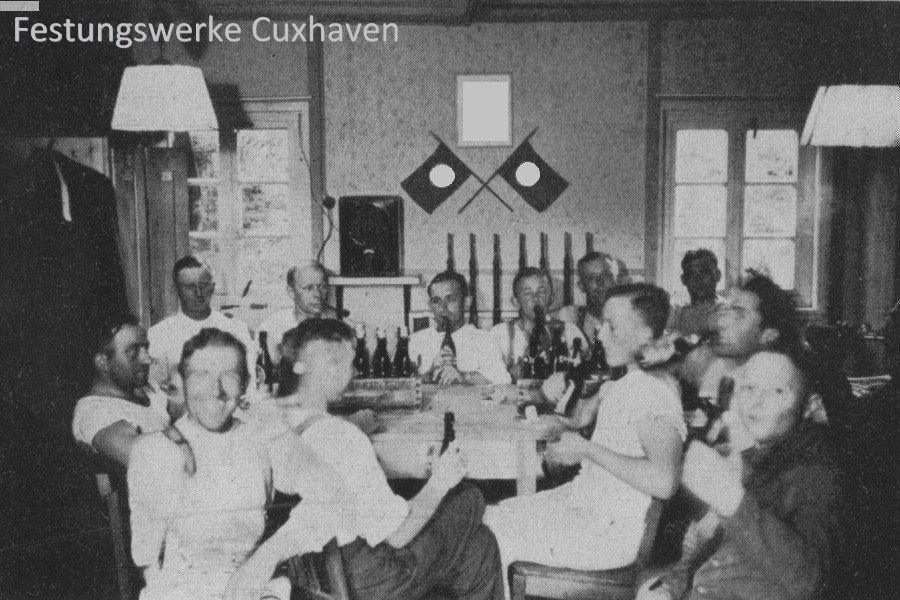
Break in the gun bunker. Even locals who were not allowed to go to the front for health or system-relevant reasons, among other things, still had to serve the people. Like the Duhner original "Walter Strohsahl" (above left), there were some who had to report to the battery as anti-aircraft helpers when the air raid warning sounded.
Source: War Chronicle of the Battery Stand Heide 1941/42

Source: War Chronicle of the Battery Stand Heide 1941/42
As often happened, our shots hit a Whitley, Blenheim, Wellington or other enemy aircraft when we were firing, so that we thought it would crash. But time and again the Tommy managed to slide over the sea. Unfortunately, just a glow of fire over the water, washed-up aircraft parts or similar are not sufficient evidence of a shot down. But when a plane was shot down by our fire - as on October 26th, for example - other batteries were usually involved, so that there was a joint shot down, as on November 12th, 1941. The pennant awarded for this was presented to us personally by the commander, Korvettenkapitän Prinz von Hohenzollern-Emden.
Winter slowly came, the northwest wind blew harder and colder, the waves rose higher on the dyke up to the stone wall, and our buildings were subjected to the first major stress test for compressive and tensile strength, which they withstood well. Except for the front part of the roof of the new barracks, which was caught by the storm, carried 50 meters further and left lying there with plenty of scratches. "Tommy" was the colloquial term during the war for the then feared but also valued enemy from England. Source: War Chronicle of the Stand Heide Battery 1941/42
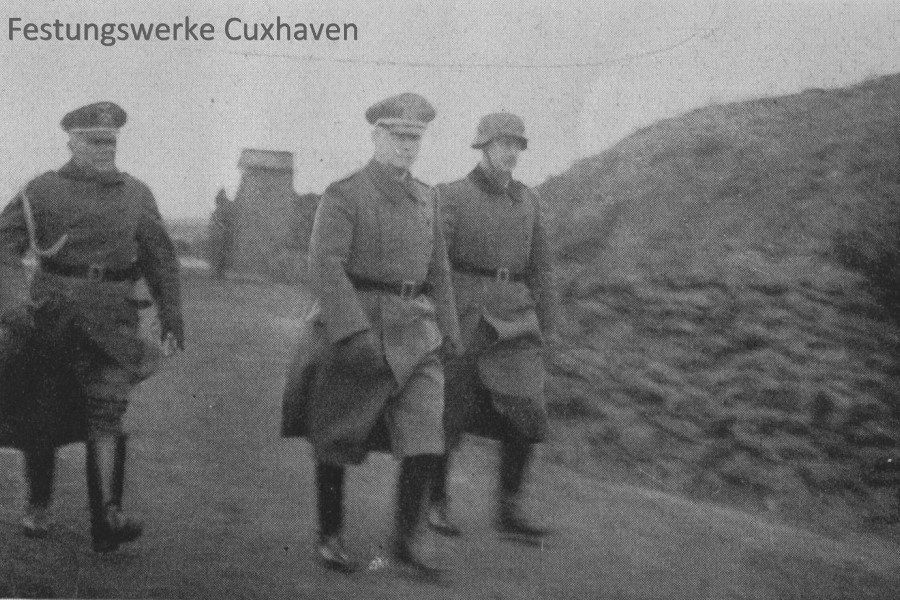
From right: Battery Commander Kptl. Brune, Commander Kvk. Prince of Hohenzollern-Emden and his adjutant.Source: War Chronicle of the Battery Stand Heide 1941/42

Handover of the first launch pennant by the commander of the anti-aircraft division.Source: War chronicle of the Stand Heide battery 1941/42
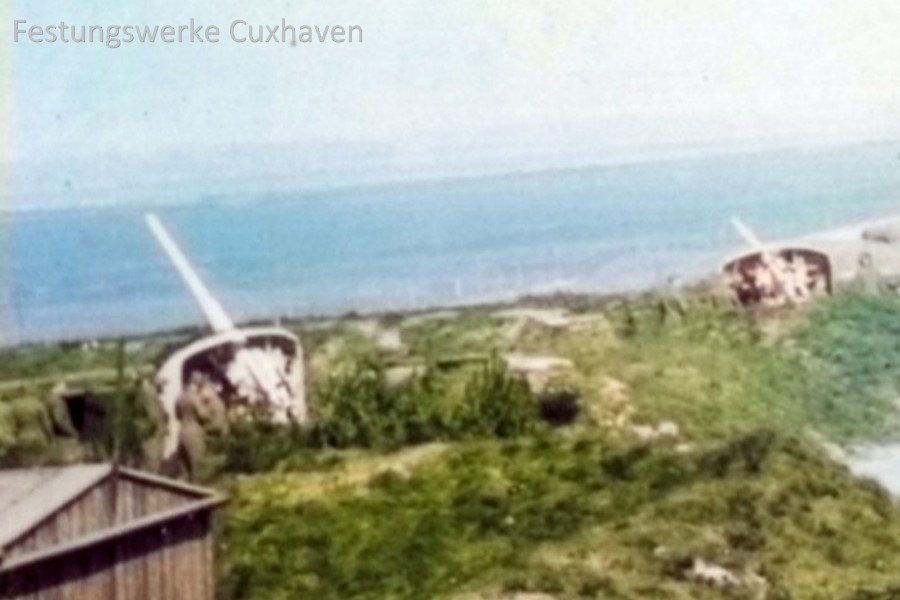
Two of the four Flak 88 SKL on the sea side of the battery (Dünenweg). In the foreground in dark green, the new land reclamation, behind it the mudflats. At that time, mainly black pines were planted there, as can be seen behind the left cannon, for example. Many of the trees are still standing today.Source: War chronicle of the Stand Heide battery 1941/42
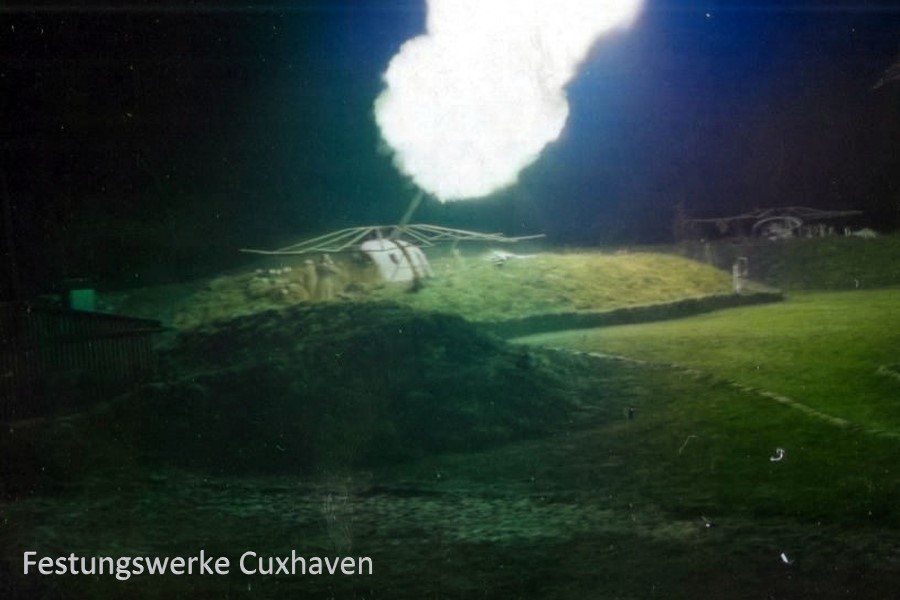
Shooting down of an Flak 88. The projectiles could reach a height of over 9000 meters in steep fire. Even today, you can find plenty of shrapnel from exploded anti-aircraft shells in the mud flats. Camouflage nets were usually attached to the cannon's frame screens. Source: War Chronicle of the Stand Heide Battery 1941/42
Kriegsweihnacht 1941
Die Weihnachtsfeier wurde mit einem eigenen Festtagsschweinebraten um 17,30 Uhr eröffnet, dem sich die Bescherung in weihnachtlich herzlicher Stimmung anschloss. Der Batteriechef sprach feierlich-ernste Worte zu dieser dritten Kriegsweihnacht und der ersten unserer Batterie im „Stand Heide"; der Weihnachtsmann erschien persönlich. Der Gabentisch war reich gedeckt - eine Flasche Wein, ein Buch mit Widmung der Batterie, Schokolade, ein großer Teller schönsten Gebäcks - und Oberfeldwebel Bienert wurde durch die freudestrahlenden Gesichter für seine große Mühe, die er damit gehabt hatte, reichlich belohnt. In den Bunkern wurde bei Punsch weitergefeiert, der leider allzu früh ausging. Vertieft wurde die Feier durch das Abschiednehmen von 48 Kameraden, die zum Jahreswechsel abkommandiert worden waren zu neuen Abteilungen.
Shortly after the turn of the year, the winter of 1942 arrived and it was even harder than its predecessor. The frost was colder, temperatures dropped to minus 30 to 35 degrees, the Wadden Sea froze far into the mouth of the Elbe, and huge ice floes formed. The east wind blew cold, sharp and unfriendly. Some time later it began to snow.
Now the path to Duhnen had to be cleared three to five times, which was done more quickly with the help of a homemade snow blower. Then it stopped snowing, but the cold remained. Despite the warmest wrapping, it crept into the fingertips, ears, and up the legs, and countless "ice legs" were brought to the shelters at night during the "rest" war watch to be thawed out. And now the success of the effort and work of the last year was noticeable: the bunkers were cozy and warm, the running water in the washrooms and showers was warm, the reading room and common room were warm, and many a thought of warm camaraderie went to the comrades in the east during these icy winter days and nights, who had to endure the terrible Russian winter in all its severity and withstand an overwhelming enemy. Off duty, trimming coal, shoveling snow and "waiting for Tommy", the long winter time was used to read, play tennis, chess and skat, for which the battery commander announced a prize competition. KdF events and the cinema helped to shorten the long evenings. Source: War Chronicle of the Stand Heide Battery 1941/42
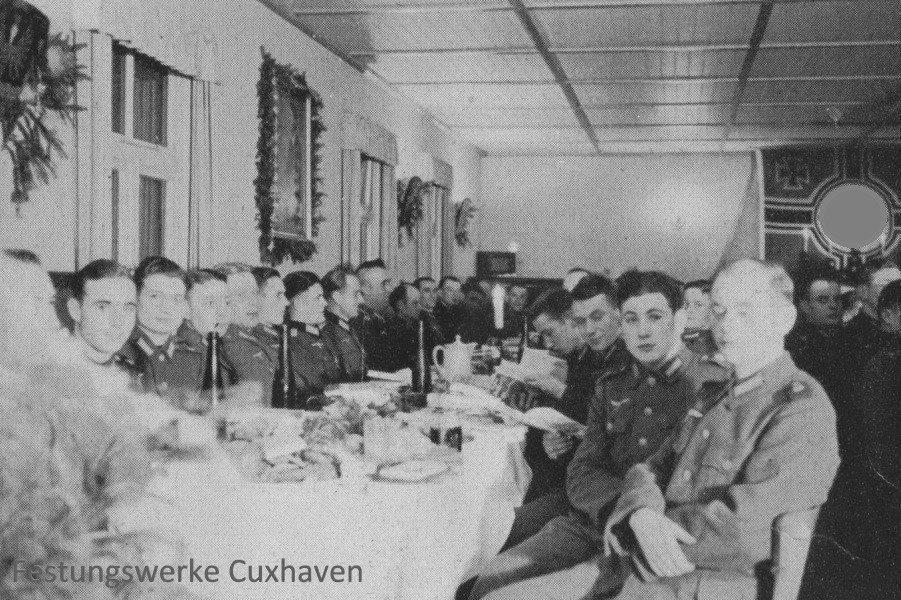
Source: War Chronicle of the Battery Stand Heide 1941/42
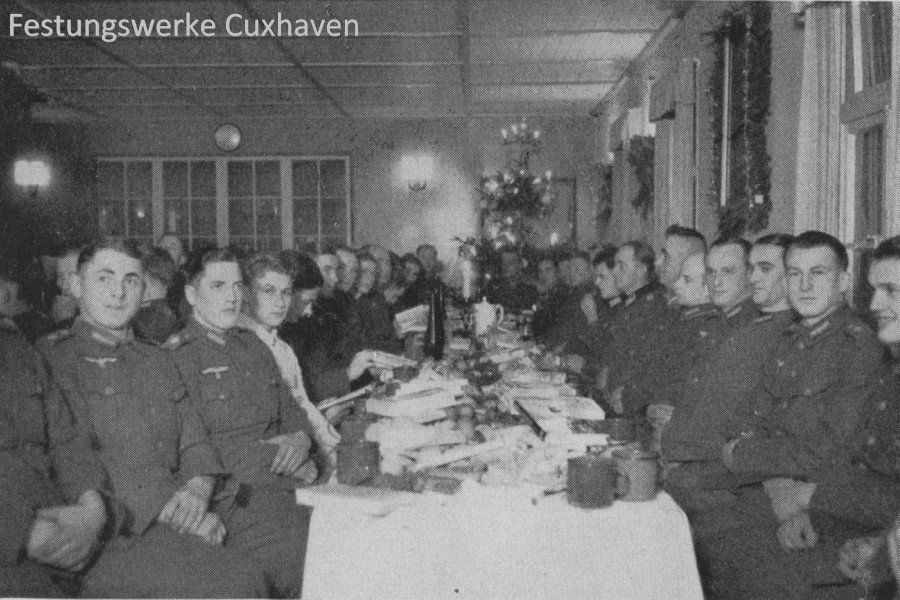
Source: War Chronicle of the Battery Stand Heide 1941/42
At the beginning of March the sun finally began to shine warmer, which was the reason for an early spring battery festival, which once again gave expression to the proven camaraderie of the "Stand-Heider" in the form of a coffee table in the presence of the commander, with singing and music. It was still unfriendly and cold and the ground was frozen, but in view of the expected new guns everyone set to work with great enthusiasm and no difficulty was too great to be overcome. Success was not lacking and in a short time the two "new ones" were there, to the great joy of the entire battery. By the end of 1941 all of the position's 8.8 cm main guns had been replaced by four 10.5 cm SK C/32 guns. In addition, a modern FuMO 201 radio measuring device for air target detection was set up in the eastern part of the battery. Then came spring 1942.
with him the promotion of Sergeant Wieting to lieutenant and the battery commander to corvette captain. Soon there were 21 different farewells. It became a reality quicker than expected and on May 10th a particularly warm and beautiful celebration was held to mark the farewell of the battery commander. For over a year he looked after the battery and gave it its face in cooperation with Lieutenant Schoenfeld, Lieutenant Wieting and all the other capable comrades. He leaves us with sadness, but also with pride in the thought that "Stand Heide" is now firmly and safely on guard to ward off the enemy whenever he comes. "Four late girls" had to leave us. "Berta, Renate, your names are fading!" Ursula and Nanní have also said goodbye, and two tough brothers have come instead. This probably refers to the replacement of four light anti-aircraft guns with two 20 mm quadruple anti-aircraft guns to defend against low-flying aircraft. Source: War Chronicle of the Stand Heide Battery 1941/42

Lieutenant SchönfeldSource: War Chronicle of the Battery Stand Heide 1941/42
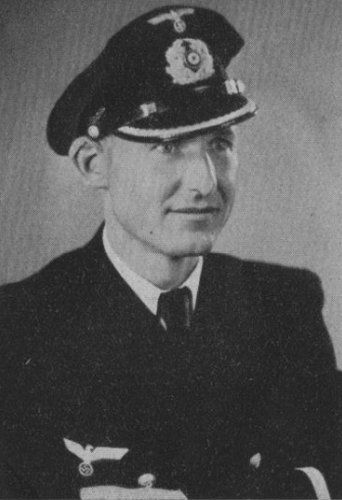
Lieutenant WietlingSource: War Chronicle of the Battery Stand Heide 1941/42
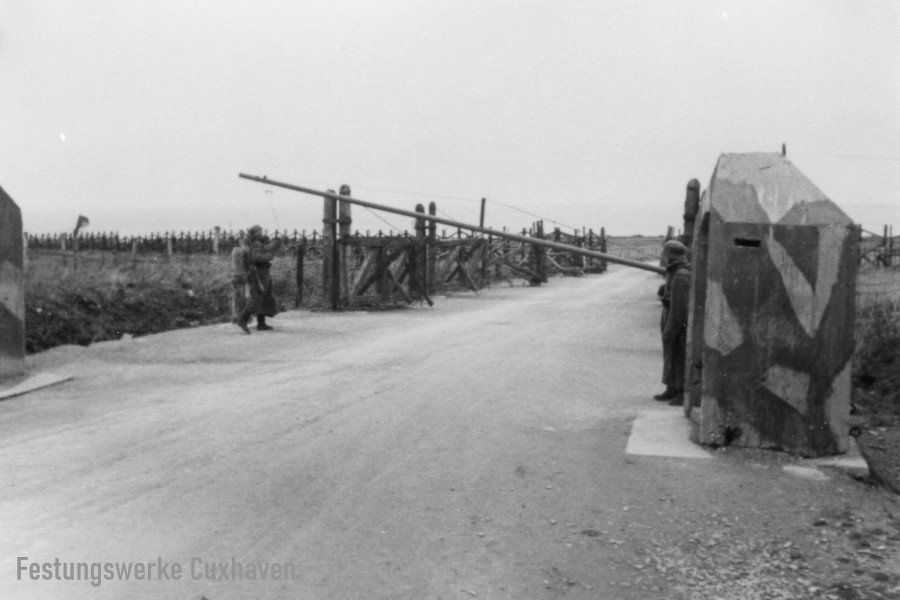
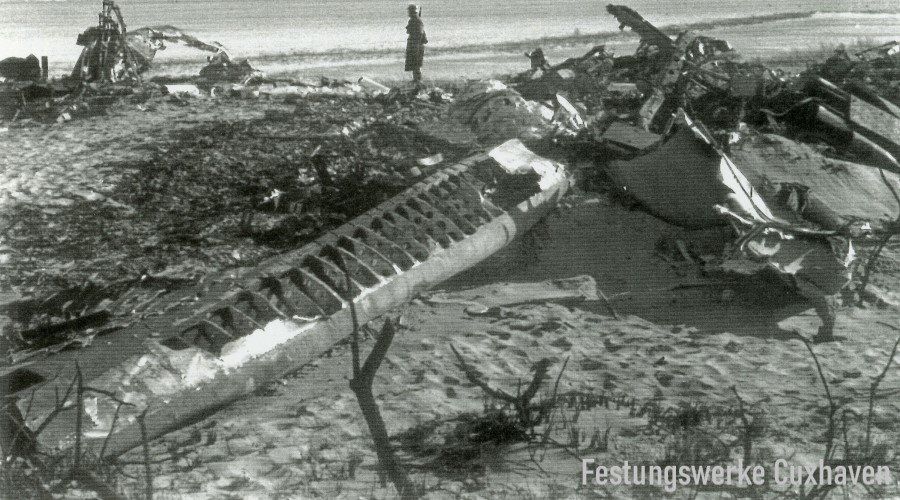
1942 / Bistrol Blenheim shot down near Stand Heide. The machine obviously crashed directly into the position. The dam in the background is probably the west side of the new land reclamation.Image source: Gerd Wildfang
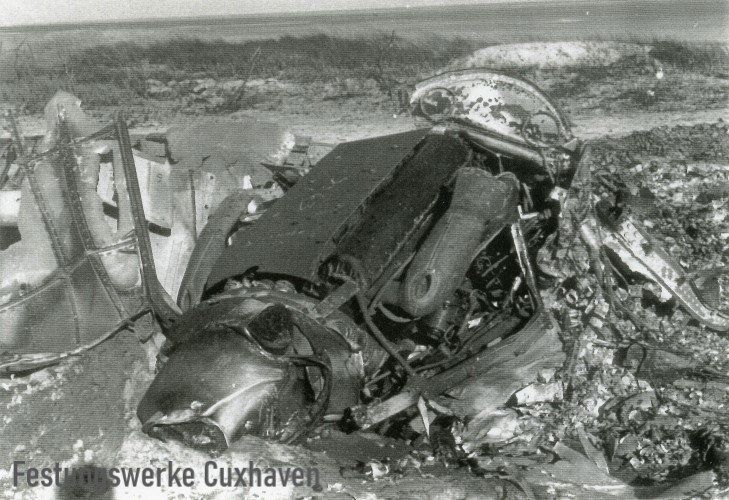
The same plane, probably looking north. Behind the dune, new land is being reclaimed.Image source: Gerd Wildfang

Unknown plane shot down in the Sahlenburger Watt. The location and time are also unknown. Here too, the crew lost their lives. Image source: Gerd Wildfang
Final picture of the battery chronicle of Stand Heide 1941/42 on 11.05.1942
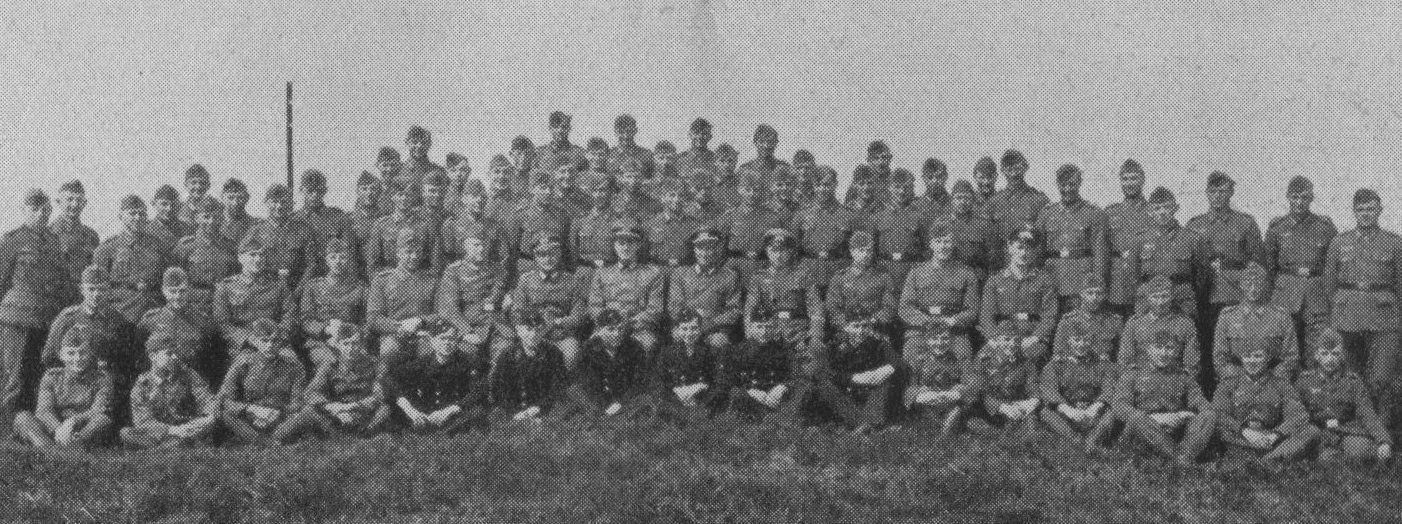
Am 27.03.1942 wurden in Stand Heide 2 x 10,5 cm Doppellafetten aufgestellt und laut Kriegstagebuch Kommandant Cuxhaven am 05.04.42 schießklar gemeldet. Damit wurde dieser Bereich mit Geschützen ausgestattet, die in der Lage waren höher fliegende Ziele zu bekämpfen. Ob dafür 2 x 8,8 cm Geschütze abgebaut oder die Doppelflak zusätzlich aufgebaut wurde, ist nicht bekannt.

In June 1943, both 10.5 cm double anti-aircraft guns were withdrawn for unknown reasons. Even the objection of the commander of the Marine Flakabteilung 214 "Prinz zu Hohenzollern Emden" could not change this situation. He feared that the sector would be weakened against high-flying combat aircraft.
Picture left:
The battery's position area in 1943. The entire area was surrounded by barbed wire. It was also equipped with anti-personnel mines all around, including on the sea side. The main access road was on the east side and was controlled by a guard post. In addition to the heavy 10.5 cm anti-aircraft guns that were set up from February/March 1943, there were further light 20 mm and 37 mm anti-aircraft guns to protect against low-level attacks. To further protect the battery against attacks from the ground, 7.5 cm anti-tank guns were set up in several places. There were also machine gun nests in some places.Map source: Gerd Wildfang/KHSchmeelke

A 10.5 cm SK/C 32 from the Stand Heide battery, in the background on the horizon you can see the fortified castle.Source:Gerd Wildfang

A little blurred, the four guns of the battery in 1944 under camouflage nets. In the foreground a barrack.Source: Gerd Wildfang
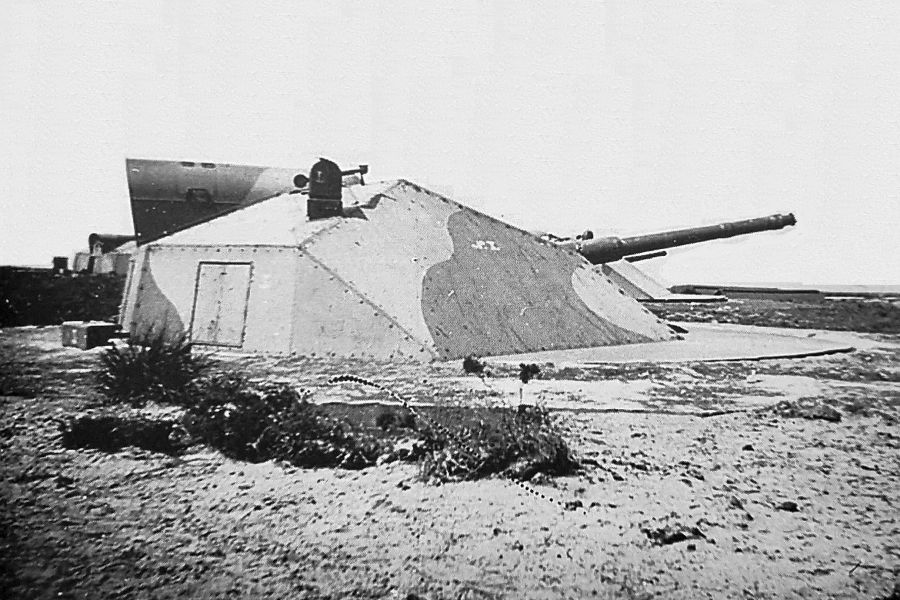
Source: Gerd Wildfang
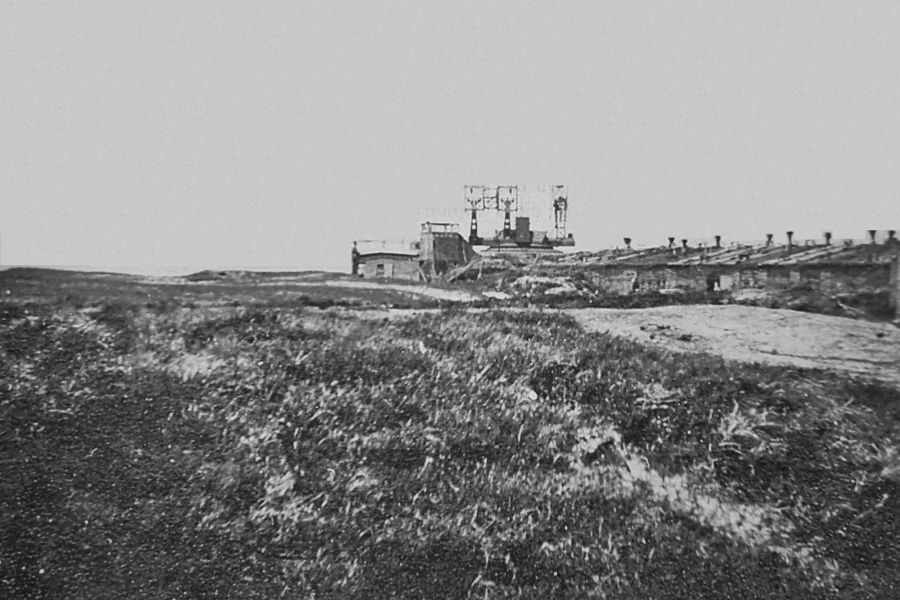
Looking north towards the lake. At the edge of the position is the FumG 41 G, in front of it a barrack.Source: Gerd Wildfang



